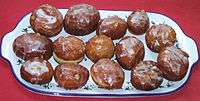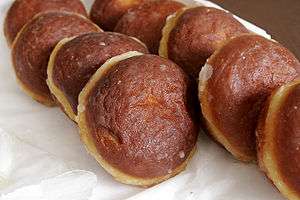Pączki
|
Traditional pączki | |
| Type | Pastry |
|---|---|
| Place of origin | Poland |
| Main ingredients | Dough, grain alcohol, confiture or other sweet filling, powdered sugar, icing or bits of dried orange zest |
|
| |
Pączki (/ˈpɔːntʃki/, PAWNCH-ki, Polish: pączki [ˈpɔnt͡ʂkʲi], singular: pączek; Old Polish and Silesian: krepel) are pastries traditional to Polish cuisine. They are similar to doughnuts.
Description
Pączki are deep-fried pieces of dough shaped into flattened spheres and filled with confiture or other sweet filling. Pączki are usually covered with powdered sugar, icing or bits of dried orange zest. A small amount of grain alcohol (traditionally, Spiritus) is added to the dough before cooking; as it evaporates, it prevents the absorption of oil deep into the dough.[1] The common opinion is that the ideal pączek is fluffy and at the same time a bit collapsed, with a bright stripe around – it is supposed to guarantee that the dough was fried in fresh oil.[2][3]
Although they look like German berliners, North American bismarcks or jelly doughnuts, pączki are made from especially rich dough containing eggs, fats, sugar, yeast and sometimes milk. They feature a variety of fruit and creme fillings and can be glazed, or covered with granulated or powdered sugar. Powidl (stewed plum jam) and wild rose hip jam[1][4] are traditional fillings, but many others are used as well, including strawberry, Bavarian cream, blueberry, custard, raspberry, and apple.[5]
Pączki have been known in Poland at least since the Middle Ages. Jędrzej Kitowicz has described that during the reign of August III, under the influence of French cooks who came to Poland, pączki dough was improved, so that pączki became lighter, spongier, and more resilient.
- Pączki displayed for sale
 Traditional pączki serowe or oponki
Traditional pączki serowe or oponki Home-made glazed pączki
Home-made glazed pączki Assorted pączki commercially produced near Detroit
Assorted pączki commercially produced near Detroit
Etymology and pronunciation
The Polish word pączki is the plural form of the Polish word pączek [ˈpɔnt͡ʂɛk].[6] Pączek itself is a diminutive of pąk (English: plant bud).[7][8]
In English, paczki serves as both the singular and plural term, though some speakers use "paczkis" for the plural.[9] Whereas sometimes the Polish spelling with the Polish letter ą is retained in English language publications,[1] many sources anglicize to paczki.[7][8]
The common English pronunciation /ˈpɔːntʃki/[8] (PAWNCH-ki) imitates the Polish phonology, though some speakers pronounce the word /ˈpʊntʃki/[7] or /ˈpʌntʃki/ (PUUNCH-ki or PUNCH-ki).
Dictionaries translate pączek as doughnut, donut and (botanically) bud.[10][11] American-style doughnuts with a hole are sometimes known in Polish as donaty[12] [dɔˈnatɨ].
Pączki Day
In Poland, pączki are eaten especially on Fat Thursday (Tłusty Czwartek), the last Thursday prior to Ash Wednesday and the beginning of Lent.[13] The traditional reason for making pączki was to use up all the lard, sugar, eggs and fruit in the house, because their consumption was forbidden by Catholic fasting practices during Lent.
In North America, particularly the large Polish community of Chicago, Detroit, and other large cities across the Midwest, Paczki Day is celebrated annually by immigrants and locals alike. The date of this observance merges with that of pre-Lenten traditions of other immigrants (e.g., Pancake Day, Mardi Gras) on Fat Tuesday. With its sizable Polish population, Chicago celebrates the festival on both Fat Thursday and Fat Tuesday; pączki are also often eaten on Casimir Pulaski Day. In Buffalo, Toledo, Cleveland, Detroit, Grand Rapids, Milwaukee, South Bend, and Windsor, Pączki Day is celebrated on Fat Tuesday.
The Pączki Day celebrations in some areas are even larger than many celebrations for St. Patrick's Day. In Hamtramck, Michigan, an enclave of Detroit, there is an annual Pączki Day (Shrove Tuesday) Parade,[5] which has gained a devoted following. Throughout the Metro Detroit area, it is so widespread that many bakeries attract lines of customers for pączki on Paczki Day.[14]
In some areas, Pączki Day is celebrated with pączki-eating contests. The contest in Evanston, Illinois, started in 2010, and is held on the weekend before Fat Tuesday, while Hamtramck's contest is held on the holiday.
United States
These pastries have become popular in the United States as a result of Polish immigrants and marketing by the bakery industry. Sold mainly for Fat Tuesday, they are particularly popular in areas where there is a large concentration of Polish immigrants: Philadelphia, the Greater Detroit and Mid Michigan areas, Central Connecticut, Greater Cleveland, Northern and Central New Jersey, Chicago and Northern Illinois, Northwest Indiana, Western Massachusetts and greater Chicopee, Milwaukee and Southeastern Wisconsin.
Derivatives
In other Slavonic countries, a meal synonymous with pączki appears in the local cuisines whose name is derived from the same etymology as pączki:[15][16]
- Russia: ponchiki (пончики), singular ponchik (пончик);[15][16] or, especially in St. Petersburg, pyshki (пышки). Ponchiki are a very popular sweet doughnut, with many fast and simple recipes available in Russian cookbooks for making them at home as a breakfast or coffee pastry.
- Bulgaria: ponichki (понички), singular ponichka (поничка); usually served with powderеd sugar.
- Ukraine: pampushky (пампушки)
In other countries neighboring Poland similar desserts are called:
- Armenia: ponchik is also enjoyed, including the typical deep-fried dough and custard or chocolate filling.
- Czech Republic: koblihy, the Czech word for doughnuts
- Finland: munkki, a dessert similar to pączki, including the filling
- Lithuania: spurgos, the Lithuanian word for doughnuts
- Slovakia: šišky, the Slovak word for doughnuts
A similar food in Israeli cuisine is called the sufganiyah.
See also
References
- 1 2 3 Strybel, Robert & Strybel, Maria (2005). Polish Heritage Cookery. Hippocrene. p. 270.
- ↑ Karolinas. "Skąd wziął się Tłusty Czwartek? Skąd wziął się Tłusty Czwartek?". Tipy.pl (in Polish). Grupa Interia.pl. Retrieved 2016-02-03.
- ↑ Anna Hudyka (edited by: Magda Głowala-Habel) (2009-02-18). "Tłusty Czwartek". Interia360.pl (in Polish). Grupa Interia.pl. Retrieved 2016-02-03.
- ↑ "Pączki? Hard to say, culinary Lenten treat made by nuns". Catholic News Service. Retrieved November 23, 2009.
- 1 2 "Pazcki day- eat and celebrate". www.hamtramck.us (official website of City of Hamtramck, Michigan). City of Hamtramck. Archived from the original on March 15, 2008.
- ↑ Jewish Language Review. Association for the Study of Jewish Languages. 1987. p. 426.
- 1 2 3 "paczki". The American Heritage Dictionary of the English Language (4th ed.). Houghton Mifflin. 2003. Retrieved 27 February 2014.
- 1 2 3 "paczki". Dictionary.com Unabridged. Random House. Retrieved 27 February 2014.
- ↑ Mary Ann Winkowski; David Christopher; David Powers (9 October 2013). Beyond Delicious: The Ghost Whisperer's Cookbook: More than 100 Recipes from the Dearly Departed. Clerisy Press. p. 291. ISBN 978-1-57860-499-9.
- ↑ http://pl.bab.la/slownik/polski-angielski/p%C4%85czek
- ↑ http://ling.pl/p%C4%85czek
- ↑ http://durszlak.pl/przepisy-kulinarne/donaty
- ↑ Barbara Ogrodowska (1996). Święta polskie: tradycja i obyczaj (in Polish). Alfa. p. 124.
- ↑ "Fat Tuesday Can Be Paczki Pandemonium". Southfield, MI: WWJ-TV. Retrieved 21 February 2012.
- 1 2 Пончик (in Russian). Дмитрий Николаевич Ушаков (ред.). Толковый словарь русского языка. Москва: Советская энциклопедия, 1935-1940. (Dmitry Ushakov. The Explanatory Dictionary of the Russian Language. Moscow: Soviet Encyclopedia Publishing House, 1935-1940)
- 1 2 Пончик (in Russian). Max Vasmer. Russisches etymologisches Wörterbuch. Winter, Heidelberg 1953–1958 (in German). Russian translation by Oleg Trubachyov: Этимологический словарь русского языка. Progress, Moscow, 1964–1973.
External links
| Wikimedia Commons has media related to Pączki. |
- Paczki Day PSA, an account of Detroit area Paczki Day traditions in 2008
- Paczkis Video produced by Wisconsin Public Television
